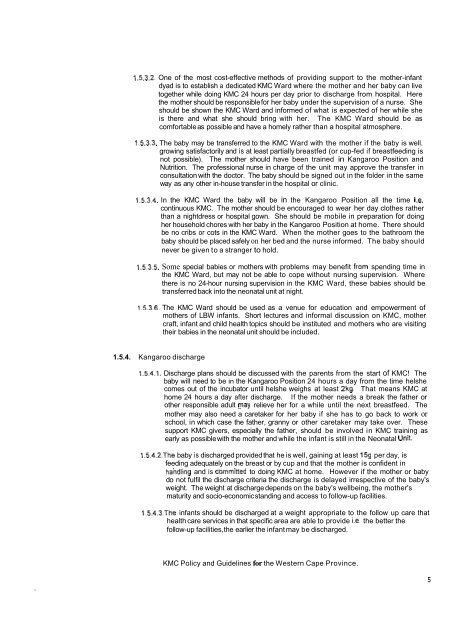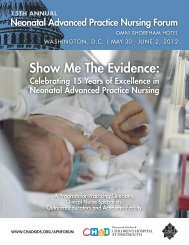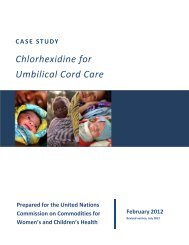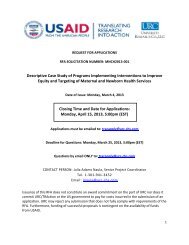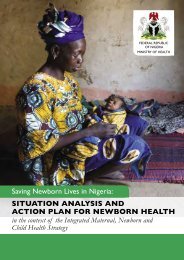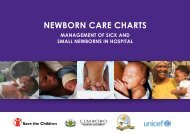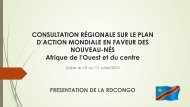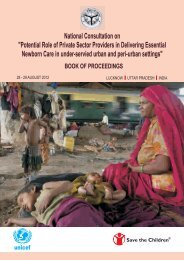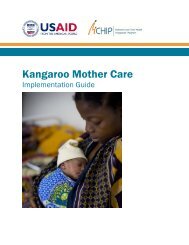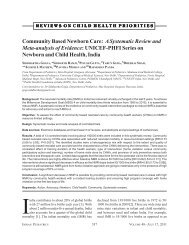Kangaroo Mother Care Policy/Guidelines - Western Cape Government
Kangaroo Mother Care Policy/Guidelines - Western Cape Government
Kangaroo Mother Care Policy/Guidelines - Western Cape Government
Create successful ePaper yourself
Turn your PDF publications into a flip-book with our unique Google optimized e-Paper software.
1.5.3.2. One of the most cost-effective methods of providing support to the mother-infant<br />
dyad is to establish a dedicated KMC Ward where the mother and her baby can live<br />
together while doing KMC 24 hours per day prior to discharge from hospital. Here<br />
the mother should be responsible for her baby under the supervision of a nurse. She<br />
should be shown the KMC Ward and informed of what is expected of her while she<br />
is there and what she should bring with her. The KMC Ward should be as<br />
comfortable as possible and have a homely rather than a hospital atmosphere.<br />
1.5.3.3. The baby may be transferred to the KMC Ward with the mother if the baby is well.<br />
growing satisfactorily and is at least partially breastfed (or cup-fed if breastfeeding is<br />
not possible). The mother should have been trained in <strong>Kangaroo</strong> Position and<br />
Nutrition. The professional nurse in charge of the unit may approve the transfer in<br />
consultation with the doctor. The baby should be signed out in the folder in the same<br />
way as any other in-house transfer in the hospital or clinic.<br />
1.5.3.4. In the KMC Ward the baby will be in the <strong>Kangaroo</strong> Position all the time i.e.<br />
continuous KMC. The mother should be encouraged to wear her day clothes rather<br />
than a nightdress or hospital gown. She should be mobile in preparation for doing<br />
her household chores with her baby in the <strong>Kangaroo</strong> Position at home. There should<br />
be no cribs or cots in the KMC Ward. When the mother goes to the bathroom the<br />
baby should be placed safely on her bed and the nurse informed. The baby should<br />
never be given to a stranger to hold.<br />
1.5.3.5. Some special babies or mothers with problems may benefit from spending time in<br />
the KMC Ward, but may not be able to cope without nursing supervision. Where<br />
there is no 24-hour nursing supervision in the KMC Ward, these babies should be<br />
transferred back into the neonatal unit at night.<br />
1.5.3.6. The KMC Ward should be used as a venue for education and empowerment of<br />
mothers of LBW infants. Short lectures and informal discussion on KMC, mother<br />
craft, infant and child health topics should be instituted and mothers who are visiting<br />
their babies in the neonatal unit should be included.<br />
1.5.4. <strong>Kangaroo</strong> discharge<br />
1.5.4.1. Discharge plans should be discussed with the parents from the start of KMC! The<br />
baby will need to be in the <strong>Kangaroo</strong> Position 24 hours a day from the time helshe<br />
comes out of the incubator until helshe weighs at least 2kg. That means KMC at<br />
home 24 hours a day after discharge. If the mother needs a break the father or<br />
other responsible adult may relieve her for a while until the next breastfeed. The<br />
mother may also need a caretaker for her baby if she has to go back to work or<br />
school, in which case the father, granny or other caretaker may take over. These<br />
support KMC givers, especially the father, should be involved in KMC training as<br />
early as possible with the mother and while the infant is still in the Neonatal Unit.<br />
1.5.4.2.The baby is discharged provided that he is well, gaining at least 159 per day, is<br />
feeding adequately on the breast or by cup and that the mother is confident in<br />
hindling and is committed to doing KMC at home. However if the mother or baby<br />
do not fulfil the discharge criteria the discharge is delayed irrespective of the baby's<br />
weight. The weight at discharge depends on the baby's wellbeing, the mother's<br />
maturity and socio-economic standing and access to follow-up facilities.<br />
1.5.4.3.The infants should be discharged at a weight appropriate to the follow up care that<br />
health care services in that specific area are able to provide i.e. the better the<br />
follow-up facilities, the earlier the infant may be discharged.<br />
KMC <strong>Policy</strong> and <strong>Guidelines</strong> for the <strong>Western</strong> <strong>Cape</strong> Province.<br />
5


